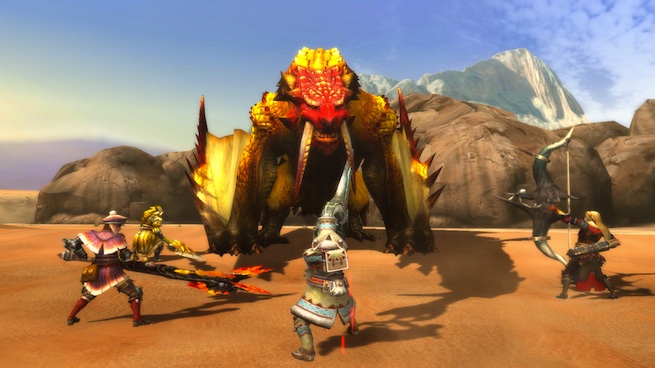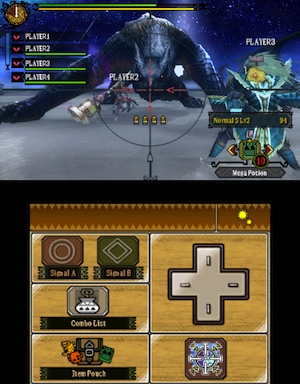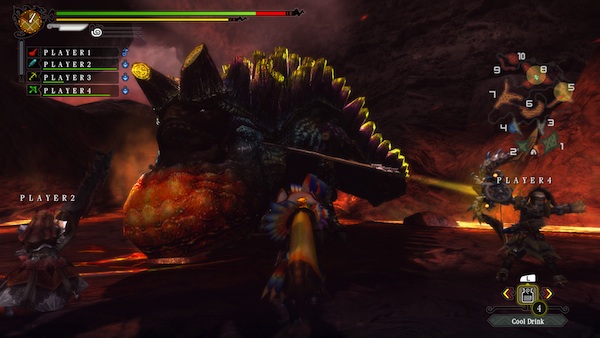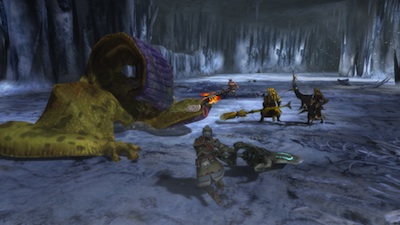Giant, menacing sword? Check. Garish armor fashioned from the bones and hides of your prey? Check. For you, it’s just another day on the job. But to them, it’s a matter of survival.
In the world of Monster Hunter, you are the invader. Your constant struggle with creatures big and small is the main draw of Capcom’s multiplayer-focused hunting game, and it can feel daunting — and almost impossible — to take down the beasts all by yourself. Monster Hunter 3 Ultimate (out March 19 for the Wii U and 3DS) makes this process a little easier, as both Wii U players and 3DS owners can play with each other locally.
Only the Wii U version, however, supports online play. But you’ll definitely want to try to wrangle up a few friends or strangers to tackle the hunting quests in multiplayer, where the difficulty kicks up to accommodate your increased firepower.
Though defeating Ultimate’s cast of monsters and upgrading your gear is your goal, we don’t know much about the creatures outside of their eating habits and locations. GamesBeat spoke with producer Ryozo Tsujimoto at a recent preview event to discuss how his team comes up with new and imaginative monsters for would-be hunters to slay.
Creating a ‘living thing’
“When we make monsters, there’s a process that we go through,” said Tsujimoto through a translator. “The first thing that we think about is, ‘Where does this monster fit within the world of Monster Hunter?’ … If we only make really big, gigantic monsters, that really won’t make the gameplay a full experience. You need to have a variety of big, small, and medium-sized monsters. They need to be able to fill many different roles and many different characteristics and responsibilities within the gameplay. So not only do we want to focus on that, but we really want to make sure that the monster is considered a living thing.”
One such living thing is the Brachydios, a new addition to the Monster Hunter bestiary. With its green-and-purple skin, the Brachydios looks like a distant but deranged cousin of Barney the Dinosaur — except instead of offering you love, it wants to destroy you with its fist-like appendages. To prepare for battle, I armed myself with a Wii U GamePad while my two partners connected to the game using 3DSes. We left Ultimate’s tropical Tanjia Port — an online hub where you can team up with other players — to one of the Brachydios’ known habitats: a fiery volcano.
Wide tail swings, explosive attacks, and damage-dealing goo almost knocked us out of the fight entirely (you share three “faints,” or deaths, among your group before you have to start over). But we prevailed, lopping off its tail before delivering the killing blow. I almost felt bad about carving its innards for raw materials.
“Although [the monsters] are just enemies that you go and hunt, we really want to make sure that we give players the feeling that these monsters are actually living in this world and you are someone who is going into their territory to hunt them down,” said Tsujimoto. “So we try to make it as realistic within the gameplay world as possible.”
Adaptation
At times, the monsters serve a functional purpose as well: In Ultimate, the developers added a number of large, sea-dwelling brutes. But fighting underwater is not the same as fighting on land, so Capcom created other fiends to teach players the difference between the two.
“What we really wanted to do was to teach players how to get to that stage first — of fighting underwater — before moving them on to fighting [the aquatic monsters],” said Tsujimoto. “So we thought, ‘How are we going to introduce this new underwater fighting element to the players?’ The idea we came up with was to create a monster that could not only live underwater, but on land as well.
“When we worked on the design of this monster, one thing we came up with is that it’d be able to absorb the water while it’s [submerged], and when it came up on land, it’d be able to release the water, kind of like a sponge. Once the water was all gone, it would shrink and it would need to go back in … to absorb more and grow back to its big size. Those kind of little details are things that the player might not notice at first or might not really care about, but we really think it’s important in order to create a world that makes sense, a world that’s consistent with what we really want the player to experience.”
While my group of hunters didn’t face the type of creature Tsujimoto described, we did fight the dragon-like Plesioth, who also roams around on land and underwater. In past Monster Hunters, you’d have to lure the Plesioth out of the water if you wanted to fight it head-on — this time you can dive right in. Though my character was noticeably slower by swimming around, I inflicted a decent amount of damage with my bow as it crawled back on land, where my teammates finished it off.
My brief time playing Ultimate convinced me that the Wii U and 3DS connectivity is the best way to play Monster Hunter (as opposed to just playing online). Sitting next to my partners — shouting for help, giving advice, and healing my character — was a key part of our victories over Plesioth and Brachydios. And with many others left to hunt, Ultimate should keep players busy for a long time … at least until the next one.
VentureBeat's mission is to be a digital town square for technical decision-makers to gain knowledge about transformative enterprise technology and transact. Learn More




